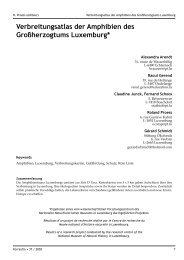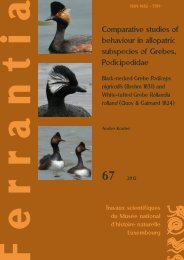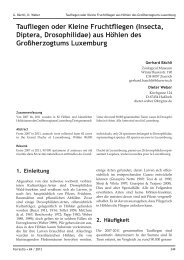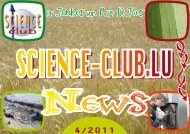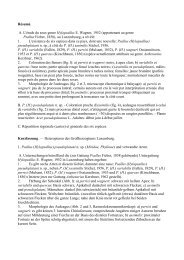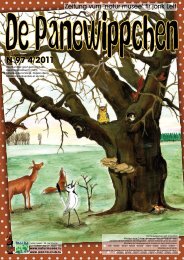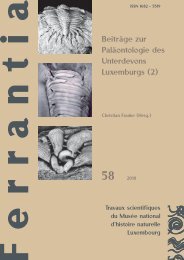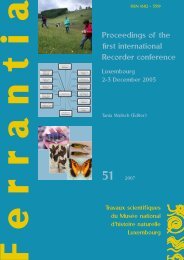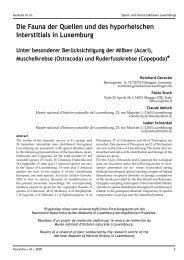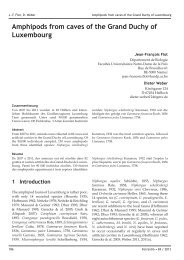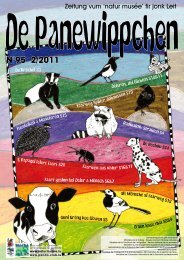Ferrantia 42 - Musée national d'histoire naturelle
Ferrantia 42 - Musée national d'histoire naturelle
Ferrantia 42 - Musée national d'histoire naturelle
You also want an ePaper? Increase the reach of your titles
YUMPU automatically turns print PDFs into web optimized ePapers that Google loves.
G. Colling Red List of the Vascular Plants of Luxembourg<br />
Symphytum ×uplandicum Nyman, a fertile hybrid<br />
of S. asperum Lepechin and S. officinale L., which<br />
has outcompeted S. asperum in many places<br />
(Lambinon et al. 2004).<br />
4. Examples of classification<br />
In the following, the use of the different threat<br />
categories is illustrated by one example for each<br />
category. In a future version of the Red List, I plan<br />
to give a similar detailed description of each taxon<br />
listed.<br />
4.1 Category RE (Regionally Extinct)<br />
Drosera rotundifolia L., Droseraceae<br />
Distribution outside of Luxembourg: Circumpolar<br />
distribution, nearly the whole of Europe,<br />
in Southern Europe only in mountainous regions;<br />
also in the Caucasus and Lebanon, Siberia, Japan,<br />
North America, Greenland.<br />
Former distribution in Luxembourg: Gutland:<br />
Beaufort Eltersmuer, Bascharage Boufferdanger<br />
Muer, Brouch Finstertal; Oesling: Wilwerdange<br />
Conzefenn, Derenbach Wald, Clervaux.<br />
Present distribution in Luxembourg: Regionally<br />
Extinct (RE).<br />
Habitat: Sphagnum bogs.<br />
Phytosociology: Carex echinata-Sphagnum bog,<br />
associated with Carex canescens, Carex echinata,<br />
Juncus squarrosus, Viola palustris, but also<br />
<strong>Ferrantia</strong> • <strong>42</strong> / 2004<br />
Eriophorum angustifolium and Vaccinium oxyococcos,<br />
vanishing if the bogs are drained.<br />
Biology: Flowers June-August, mostly self-pollinated;<br />
sexual reproduction and clonal growth;<br />
perennial.<br />
Status and threats: Used to be locally quite<br />
common in Sphagnum mires and marshes (Koltz<br />
1873). Formerly known from 6 localities. The<br />
species became extinct at the last known locality<br />
in Bascharage Boufferdanger Muer in 1983.<br />
Regionally Extinct (RE)<br />
Recovery goal: Since no stock is cultivated and<br />
seed is held by no institution, a reintroduction<br />
from Luxembourg material is not possible but the<br />
species could be reintroduced from material of<br />
extant Belgian localities.<br />
4.2 Category CR (Critically Endangered)<br />
Arnica montana L., Asteraceae<br />
Distribution outside of Luxembourg: European<br />
sub-oceanic distribution, in mountainous regions<br />
of Central Europe and in Western Europe from<br />
northern Spain through the French central plateau<br />
to Belgium, Luxembourg and the Netherlands.<br />
Former distribution in Luxembourg: Gutland:<br />
Beaufort; Oesling: Rambrouch, Brachtenbach,<br />
Eselborn, Troine Sporbech, Derenbach Wald,<br />
Moulin de Bigonville, Wilwerdange Conzefenn,<br />
Doennange Nesselbirchen, Berlé Bamels, Grosbous<br />
Neiwis, Basbellain Fenn, Weicherdange Breichen,<br />
Binsfeld Hounert.<br />
Fig. 3: Drosera rotundifolia, 30.9.2001, Belgium, Marais de Vance. Photo: C. Reckinger.<br />
11



